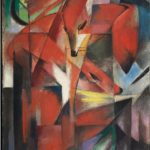
Bonn, Germany.- The Art & Exhibition Hall of the Federal Republic of Germany is proud to present “Anime! High Art – Pop Culture”, on view through January 8th 2012. Anime, the specifically Japanese form of animated cartoons, has been a hugely successful fixture in Germany since the 1970s, captivating the imagination of young and old alike. An umbrella term, Anime describes a wide variety of techniques employed to make drawings come to life in film. Alongside Manga, the Japanese comic strip, Anime has developed an international pictorial language that appeals to audiences of all ages. Brightly coloured, catchy and energetic, the films and series such as Vicky the Viking, Heidi – Girl of the Alps, Captain Future, Akira, Sailor Moon, Princess Mononoke, Pokémon or Spirited Away have not only left their mark on everyday life in Japan, their high artistic quality and fascinating story lines are also a major influence on ‘high art’ and popular culture in general.
The Art and Exhibition Hall presents the history, aesthetics and production methods of Japanese Anime. From the very beginnings to the great box office hits and popular small screen heroes of the late 1970s and, finally, to the current computer games, the exhibition explores the fascination of Anime and its often breathtakingly dramatic pictorial language. Organised around genres, the individual sections of the exhibition present a richly varied array of material on pop culture, production, reception, fandom and merchandising. The tour of the exhibition begins with Anime for children (Kodomo no Anime), presenting the early coproductions by German and Japanese studios as well as cels from the famous Studio Ghibli.

The Shojo Anime genre is primarily geared towards young girls, while boys tend to be more interested in the ideals of Shonen Anime: endurance, friendship and sincerity in the fight against monsters and evil powers. But the appeal of Anime is not limited to children and teenagers alone; adults enjoy “Seinen Anime”, which ranges from Eroticism to Fantasy and Science Fiction. The exhibition ends with an exploration of the current situation in Japan as reflected in contemporary Anime. The displays are complemented by ‘high art’ by Amano Yoshitaka, photographs of ‘cosplayers’ by Oliver Sieber and costumes of actors playing Anime characters. The exhibition is accompanied by a comprehensive film programme for children and adults.
Prior to the development of computer assisted animation all the individual images of an anime, that is motion sequences and backgrounds, were painted by hand. A sketch (genga) forms the basis for the finished drawing (d?ga) which is transferred onto a transparent sheet. These so-called cels (celluloids) are fixed on a runner, layered on top of each other in front of a background and eventually shot on film. Each picture is painted on its own separate sheet and can therefore be moved individually (layer technique). The impression of motion can be created by exchanging individual cels or by background and camera movement. The total number of cels distinguishes full and limited animation. Full animation uses at least 12 individual cels per second. An animation using less cels is defined as limited animation, a technique that is most of all time and cost effective, but sometimes also used consciously as a stylistic device. Motion sequences appear more jumpy and rough when compared to full animation, which allows for greater detail of gestures and facial expressions, as well as smoother movements with its higher number of individual cels.
Anime based video and computer games are a popular audiovisual part of Japanese youth culture. As globally distributed commodities these games are easily accessible outside the Japanese market and cultural context. Their presentation and thematic orientation are closely related to anime. Despite their fundamentally different form, anime could be seen as the predecessors of these Japanese computer games. Today, besides the many interactive adaptations of manga and anime that are produced, we often find examples going in the opposite direction: anime and manga which are based on popular computer games. The term “Mecha” deriving from the English mechanics, means a colossal combat robot. This is controlled by a pilot either from inside a cockpit or via remote controls. The mobile mecha are not only designed for battle with their destructive powers, they are furthermore a source of protection from outside dangers.

In some anime the heroes battle with the help of cyber suits. These mechanical battle suits are designed to reinforce the protagonists‘ own power while protecting their bodies at the same time. The vision to create artificial intelligence capable of solving problems, as well as acting and feeling like a human being has a long tradition. The human desire to create man-machines, cyborgs or artificial life with the aid of biotechnology on the one hand reflects a progressive, modern society‘s fear of the increasing speed of technological development. On the other hand this aspect examines the philosophical concept of the extension of human existence with the help of scientific innovations. The artificial being is perceived as disturbing. The resulting conflict between artificial intelligence and humanity is illustrated by many anime.
The Kunst und Ausstellungshalle der Bundesrepublik Deutschland (Art and exhibition hall of the Federal Republic of Germany) is a museum in Bonn, Germany. Located on the Museum Mile in Bonn it has exhibitions of art treasures and important cultural objects from around the world. It has an exhibition area of 5600 square meters and is one of the most visited museums in Germany. 2-4 exhibitions are an view at the museum at any one time and the museum also hosted the World Chess Championship in 2008. Visit the museum’s website at … www.kah-bonn.de







